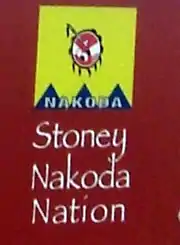Nakoda (Stoney)
The Nakoda (also known as Stoney or Îyârhe Nakoda) are an indigenous people in Western Canada and, originally, the United States.



.jpg.webp)
They used to inhabit large parts of what is now Alberta, Saskatchewan and Montana,[1] but their reserves are now located in Alberta and in Saskatchewan, where they are scarcely differentiated from the Assiniboine. Through their language they are related to the Dakota and Lakota nations of the Great Plains and the Rocky Mountains, part of the large Sioux Nation.[2]
They refer to themselves in their own language as "Nakoda", meaning friend, ally. The name "Stoney" was given them by white explorers, because of their technique of using fire-heated rocks to boil broth in rawhide bowls. They are very closely related to the Assiniboine, who are also known as Stone Sioux (from the Ojibwe asinii-bwaan).
Alberta's Nakoda First Nation comprises three bands: Bearspaw, Chiniki and Wesley.[3]
The Stoney were "excluded" from Banff National Park between 1890 and 1920.[4] In 2010 they were officially "welcomed back".[5]
Stoney groups
The Stoney are descendants of individual bands of Dakota, Lakota and Nakota, in particular of western groups of Assiniboine, from which they spun out as an independent group at about 1744. The Stoney were divided geographically and culturally into two tribal groups or divisions with different dialects, which in turn were further divided into several bands:[6][7]
Wood Stoney (Chan Tonga Nakoda – ‘Big Woods People’, often called Swampy Ground Assiniboine, northern tribal group)
- Alexis' band (Stoney, Métis, Woodland Cree)
- Paul's band (Danezaa, Stoney, Woodland Cree, Iroquois)
Mountain Stoney (Ye Xa Yabine Nakoda or Hebina – ‘Rock Mountain People’, often called Strong Wood Assiniboine, Thickwood Assiniboine, southern tribal group)
- Wesley's (Goodstoney's) band (Stoney, Plains Cree, Métis)
- Chiniki's band (Métis, Stoney, Plains Cree)
- Bearspaw's band (Stoney, Cree)
- Sharphead's band (Chipos Ostikwan's Nakoda, Wolf Creek Stoney or Pigeon Lake Stoney, often called Plains Assiniboine) (Stoney, Métis)
Treaties
Members of the Nakoda nations of Paul and Alexis signed an adhesion to Treaty 6 in 1877.
In 1877, representatives of the Nakoda Nations of Bearspaw, Chiniki and Wesley met with representatives of the British Crown to discuss the terms of Treaty 7.[8] In exchange for use of traditional native lands, the Crown agreed to honor their right to self-government and an ancestral way of life. They were also promised reserve lands, 279 km² situated along the Bow River between the Kananaskis River and the Ghost River, which became the Big Horn, Stoney and Eden Valley reserves, shared between the Bearspaw, Chiniki and Wesley tribes.
Further reading
- John Snow, Chief:[9] These Mountains Are Our Sacred Places. The Story of the Stoney People. Univ of Toronto Press, 1977; Dundurn 1994; Fitzhenry & Whiteside 2006
Notes
- "Stoney Nation: Our History". Stoney Nation Website. Stoney Nation. Retrieved 2009-06-12.
- v. article Nakota
- "Bearspaw, Chiniki, Wesley Nakoda Nations (Stoney)". Treaty 7 Management Corporation. Archived from the original on 2009-03-02. Retrieved 2009-06-12.
- "Let the Line Be Drawn Now: Wilderness, Conservation, and the Exclusion of Aboriginal People from Banff National Park", Environmental History, Vol. 11, No. 4, Oct., 2006
- The Stoney Nakoda Nation is welcomed back to Banff National Park | First Nations in British Columbia Portal
- Raymond DeMallie, William Sturtevant: Handbook of North American Indians: Plains, ISBN 978-0-16-050400-6, pp 596 - 603
- Northwest Plains History Archived November 26, 2010, at the Wayback Machine
- "Articles of Treaty No. 7". Treaty 7 Management Corporation. Archived from the original on 2009-03-01. Retrieved 2009-06-12.
- January 29, 1933 – June 15, 2006; Book-Excerpt